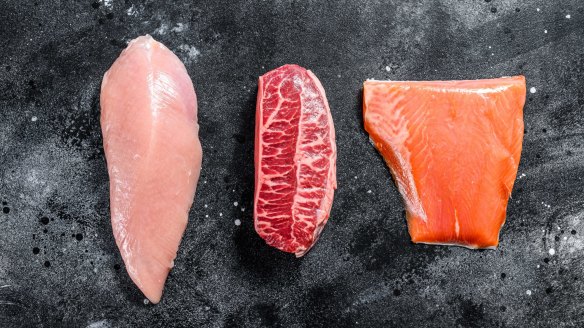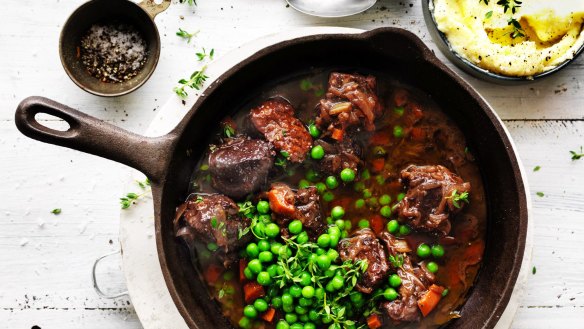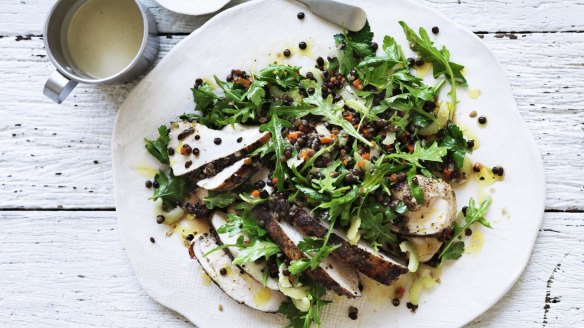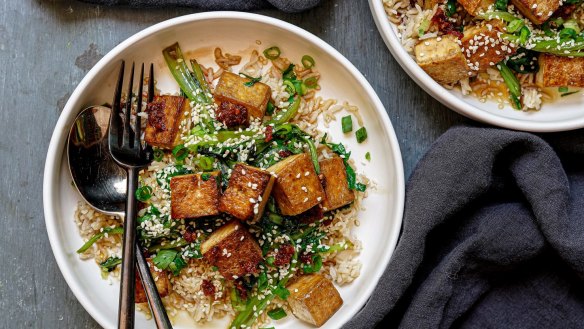Meat, chicken or fish? A dietitian's guide on how to balance your proteins

Gone are the days of Australian families eating the same meat-and-veg dishes on repeat night after night. Now, the typical weekly line-up often stars a variety of international flavours that includes a range of different proteins, including plant-based meals and pre-made options.
As a dietitian, rather than plan meals around old family favourites, I cook according to nutrient requirements, knowing that a mix of meat, chicken, fish and vegetarian meals will offer the key nutrients required each week, especially in the diets of busy, growing children.
If you have never thought about your own menu this way, here is the easy way to strike a nutritional balance with different meal proteins.

Lean meat
For people who eat meat, it's important to know that adults need a small amount of lean red meat three to four times each week in order to receive enough well-absorbed iron. Adequate dietary iron is crucial for energy production, brain development in children and immune function. This does not mean you need to eat a 500g steak every time you eat red meat. Instead, consider 100-150g serves of lean cuts, which are exceptionally rich in iron, zinc and vitamin B12, with some omega-3 fat, selenium and vitamin B6 as well. Beef is especially rich in nutrients, as is lamb, however pork, while still nutrient-rich, is significantly lower in iron. If you choose to eat red meat less frequently, make sure you are getting adequate iron from other foods to avoid low iron levels, which affect up to one in four Australian women.
How often? Three to four times each week, 100-150g serves.
Healthiest cuts: Extra lean mince, fillet steak, lean cutlets, extra lean sausages, lamb back strap.
Best cooking method: Grilled, or pan-fried with extra virgin olive oil.
Avoid: Fatty chops, regular mince and extra large steaks.

Chicken
While chicken and specifically chicken breast are exceptionally lean compared to red meat, and rich in key nutrients including vitamin B, zinc and magnesium, poultry meat lacks the rich iron content of lean red meat. This is why it does not need to be included as frequently on the weekly menu. Also keep in mind that thighs, wings and drumsticks can be extremely high in fat, with 20-30 per cent fat per serve.
How often? One to two times each week.
Healthiest cuts: Chicken breast, tenderloins, extra lean chicken mince.
Best cooking methods: Grilled, roasted, poached.
Avoid: Chicken skin, thighs, drumsticks and wings, which are much higher in fat and lower in nutrients than chicken breast.

Fish
While many of us know that fish is good for us, the reality is that very few Australians eat the two to three serves of fish we need to get enough omega-3 each week. Omega-3 fats are a special type of fat found in very few foods that have a powerful anti-inflammatory effect in the body. Omega-3 fats also help to ensure that our overall fat balance in the body is right, which in turn supports immune function, heart health and longevity. Ideally we need to consume fish rich in omega-3 at least twice a week. In saying this, all fish is food for us, and shellfish including prawns, oysters and mussels are exceptionally rich in nutrients, offering iron, zinc, iodine and some omega-3 fat, which means they can be included in a target of two to three fish or seafood meals each week.
How often? Two to three times each week.
Healthiest types Shellfish, omega-3 rich salmon, white fish including barramundi.
Best cooking methods Steamed, poached, baked.
Avoid Fried varieties.

Vegetarian options
As we learn more about nutrition, so too do we learn more about the importance of eating plant-based meals. Meat-free dishes are a rich source of dietary fibre and vegetables, and are also generally lower in energy. Whether your family's preference is for vegetarian lasagne, a tofu stir-fry or a bean-based Mexican dish, going meat-free once a week will help boost your plant food intake. As plant-based meals are generally cheaper than meat and other protein-rich options, they will also help keep the budget in check.
How often? One to two times each week.
Healthiest type: Meals based on legumes and vegetables.
Best cooking methods: Roasted, baked.
Avoid: Heavy cheese and cream-based meals or anything deep fried.
Susie Burrell is a nutritionist and dietitian.
The best recipes from Australia's leading chefs straight to your inbox.
Sign up